|
|
Post by codystarbuck on Jun 7, 2018 14:35:25 GMT -5
Captain America #286
Creative Team: JM DeMatteis-story, Mike Zeck-pencils, John Beaty-inks, Diana Albers-letters, Bob Sharen-colors, Mark Gruenwald-editor, Jim Shooter-dictator....I mean editor-in-chief. Synopsis: Our story opens on the deserted streets of New York, circa 1991. A man is roasting his dinner, while a rather sarcastic narrator lets us know that the population, housing and food price problems are a thing of the past, though cannibalism is more common, as are random murders, as we see our cook bashed over the head with a pipe. Turns out, the narrator is Luther Manning, the human one, who is wearing Deathlok's uniform, but lacks the cybernetic parts. he is being prepped by Godwulf for a trip back through time, which drops him off at a subway terminal in our present (well, back in 1983). Luther spasses for a moment and runs off, to get away from the crowd. he had forgotten what it was like, before the wars. The computer reminds him that his memories are implants, from the original Luther Manning, as this is a cloned body. Meanwhile, Cap and Nomad (the former 1950s Bucky, better known as Jack Monroe) are having a training session. Cap is concerned that Jack is insecure and it is holding him back, after years in cryogenic suspension, after becoming Bucky at age 15. Jack seems to rely on Cap for support and Cap thinks he needs to stand on his own. He basically says he is nothing on his own, and pushes Jack into reacting and fighting Cap, to break a hold. Jack realizes that Cap set him up, to face that idea. Luther Manning is holed up, while his internal dialogue reminds him that he is a clone of Luther Manning and that he seems to lack purpose. He is searching for Deathlok, looking for some answers. Some police spot him and connect him with the report about the subway incident. They approach with guns drawn and Luther tries to flee and they open fire. Luther defends with his laser, while reflecting back on the events of the Deathlok series. Luther escapes as the police car blows up from a laser blast. Meanwhile, Steve Rogers is on the train and meets up with girlfriend Bernadette "Bernie" Rosenthal, who is taking him to dinner, at her folks' house. They pass a deserted Brand Corporation facility (another evil corporation that churned out experiments run amok), just as Luther Manning is on Long Island, tracking Deathlok's bio-metric signals. he feels ill and collapses, wondering if he is dying. He stumbles into the road, outside the Brand Corp facility, narrowly missing being hit by bernie's VW. Luther climbs the fence, muttering that he must find Deathlok, and heads inside and Steve tells Bernie that he must go after him (Bernie knows that Steve is Captain America). Captain America confronts Luther Manning... 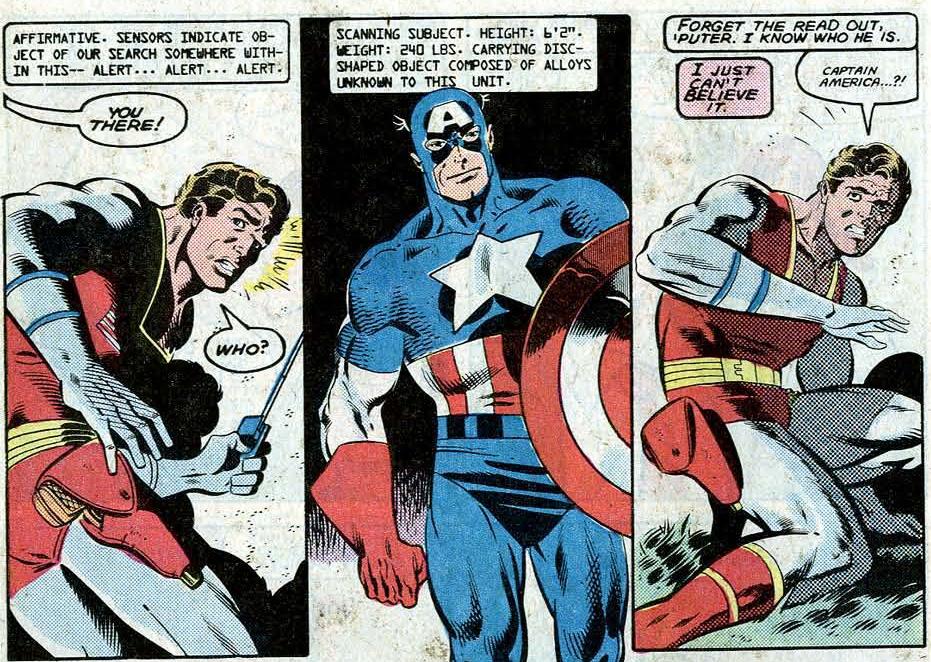 Luther tells Cap his story and Cap believes him. The follow the scanner and are attacked by goons. They fight their way into a genetics lab, where Luther goes down after a laser blast, from Deathlok... 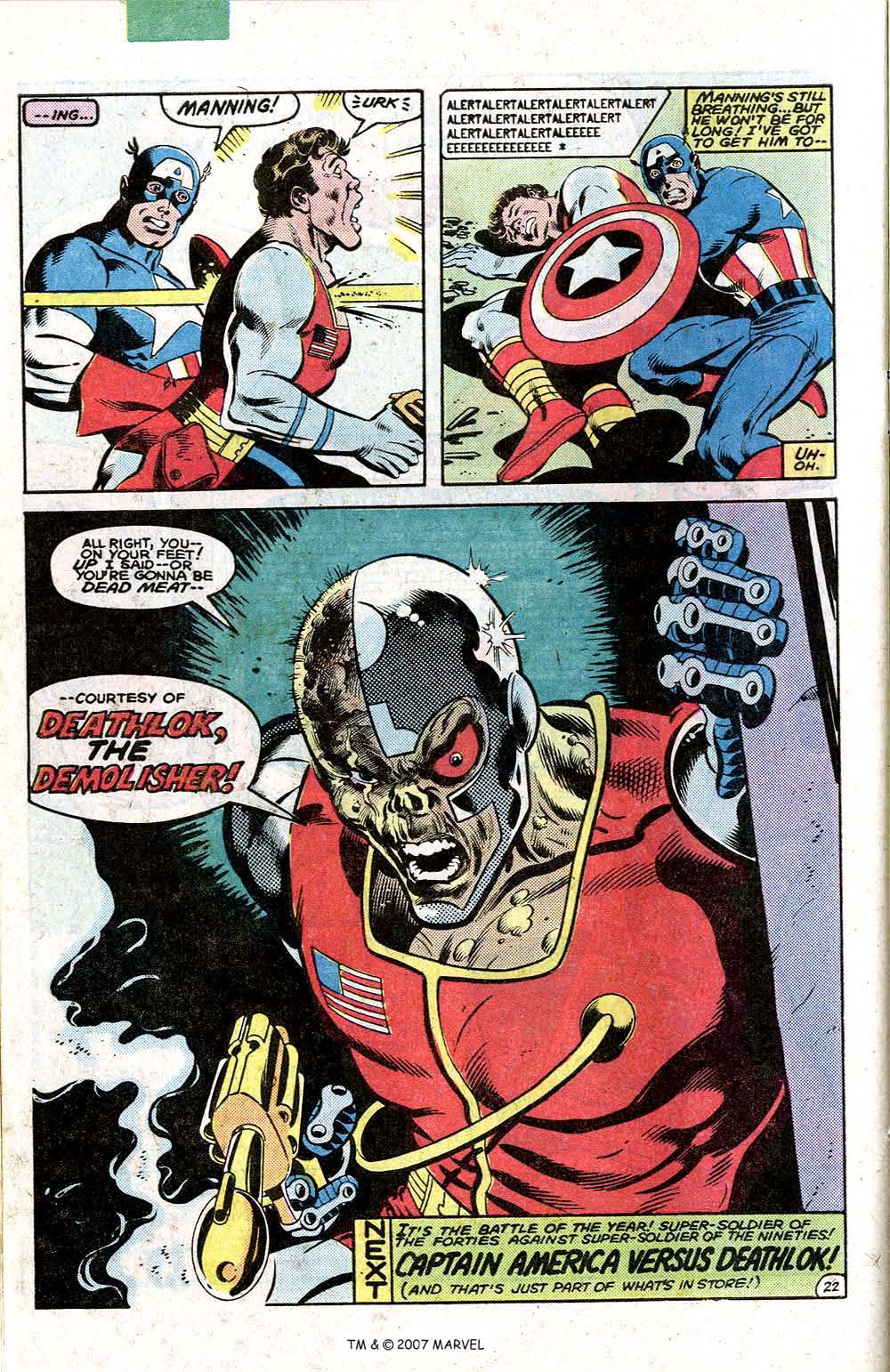 Thoughts: Thoughts: Intriguing issue! If you were a Deathlok fan, you were hooked by Zeck's spectacular cover, alone. If you opened the book, the sight of Luther Manning in Deathlok's gear, without cybernetics, was enough to keep you reading. If you were a Cap fan, you had probably been following along this excellent run from DeMatteis and Zeck, which had featured the return of Jack Monroe, the return of Helmut Zemo (last seen as The Phoenix, way back), a Howling Commando reunion and battle with HYDRA and Baron Strucker (sort of), Arnim Zola, and the revelation, to Bernie Rosenthal, that Captain America was her boyfriend, Steve Rogers. DeMatteis wrote some excellent stories and had some great interpersonal drama, while Zeck was coming into his own, as an artist. He had a cult following, from master of Kung Fu; but, this run boosted his profile, leading to his breakout turn on the Punisher. I have one quibble with the truly great cover; Cap is seen in what appears to be a telescopic sight, yet there is no such device on Deathlok's laser pistol. What appears to be a reflection in a scope is actually the tip of the barrel, of the weapon. I think Zeck got a bit confused when he drew the image. Deathlok's original laser did have a crosshair sight; but, Zeck does not draw that. Minor point; but, it always bugged me. The Brand Corporation (inspired by the Rand Corporation think tank, I would assume)appeared in Spider-Man and was or is later a subsidiary of the Roxxon Corporation, the evil energy conglomerate created by Steve Engelhart (name based on Exon and the Rockefellers). They were at the heart of battles over the Serpent Crown (Avengers) and the Nth Command attacks on Project Pegasus (in Marvel Two-in-One). When we last saw Deathlok, he was completely robotic and was destroyed in battle with the Thing and Quasar (and Pegasus security guards) and his own self-destruct mechanism. At that point, we are led to believe the rganic matter is gone, replaced by further mechanical parts. The end of this would suggest all was not what it would seem!
|
|
|
|
Post by codystarbuck on Jun 7, 2018 15:11:12 GMT -5
Captain America #287 Creative Team: Creative Team: same as last issue Synopsis Cap holds the wounded Luther Manning as deathlok commands him to get up. Cap believes Luther is dead, until Luther summons enough strength to mutter that he is alive. However, the internal computer voice has gone loopy. Cap attacks Deathlock; but, the cyborg's mechanical strength and reflexes are more than a match. Luther detects something is wrong with Deathlok. Cap fights Deathlok, trying to reawaken the Luther Manning mind within. The clone Manning watches and realizes his purpose in this. The malfunctioning computer voice confirms. Security is summoned and Cap is swarmed, allowing Deathlok to bash him with a pipe, knocking him out. Luther's mind reaches out to Deathlok and he drops the pipe, turns and walks over to Manning. He reaches out his hand and they touch, transferring Luther's mind back into Deathlok's body. Luther realizes why he was weaker the nearer he got to Deathlok. He needed to be whole again, not split in two. It unlocks the memories in Deathlok...  We see that the organic parts were removed from Deathlok and the fully robotic version was destroyed by Quasar. Roxxon/Brand rebuilt the cyborg parts, putting the organic tissue back with it. Luther's mind is back in the brain, interacting with the computer. It remembers and it is slightly miffed! Deathlok unloads on the Brand goons, killing left and right. cap gets him to stop and agree to with draw, without further bloodshed. He carries the lifeless Luther clone and deathlok fires at the main power source, which causes a chain reaction, destroying the facility, killing ll left inside. We get interludes of Bernie's parents complaining about the absence of Steve Rogers, who they believe is meeting a dealine. Bernie tells them off, while worrying about Steve, as she knows Cap went inside Brand and the family has heard the explosion and emergency response sirens. Jack Monroe stops a mugging and the lovely victim is most appreciative. We cut back to Deathlok and Cap, who have buried the Luther clone. deathlok heads off to find the time portal back to 1991, while Cap remembers Bernie's family. However, he is fixated on something Deathlok said, about the lack of superheroes and he follows, asking for clarification. Deathlok says all the heroes disappear in 1983, which is now (then). Cap follows and ends up caught in the energy field that brings Deathlok back to Godwulf. Cap pops in right behind him and Godwulf recognizes him. he takes Cap to see the destroyed world, before giving him the whole picture... 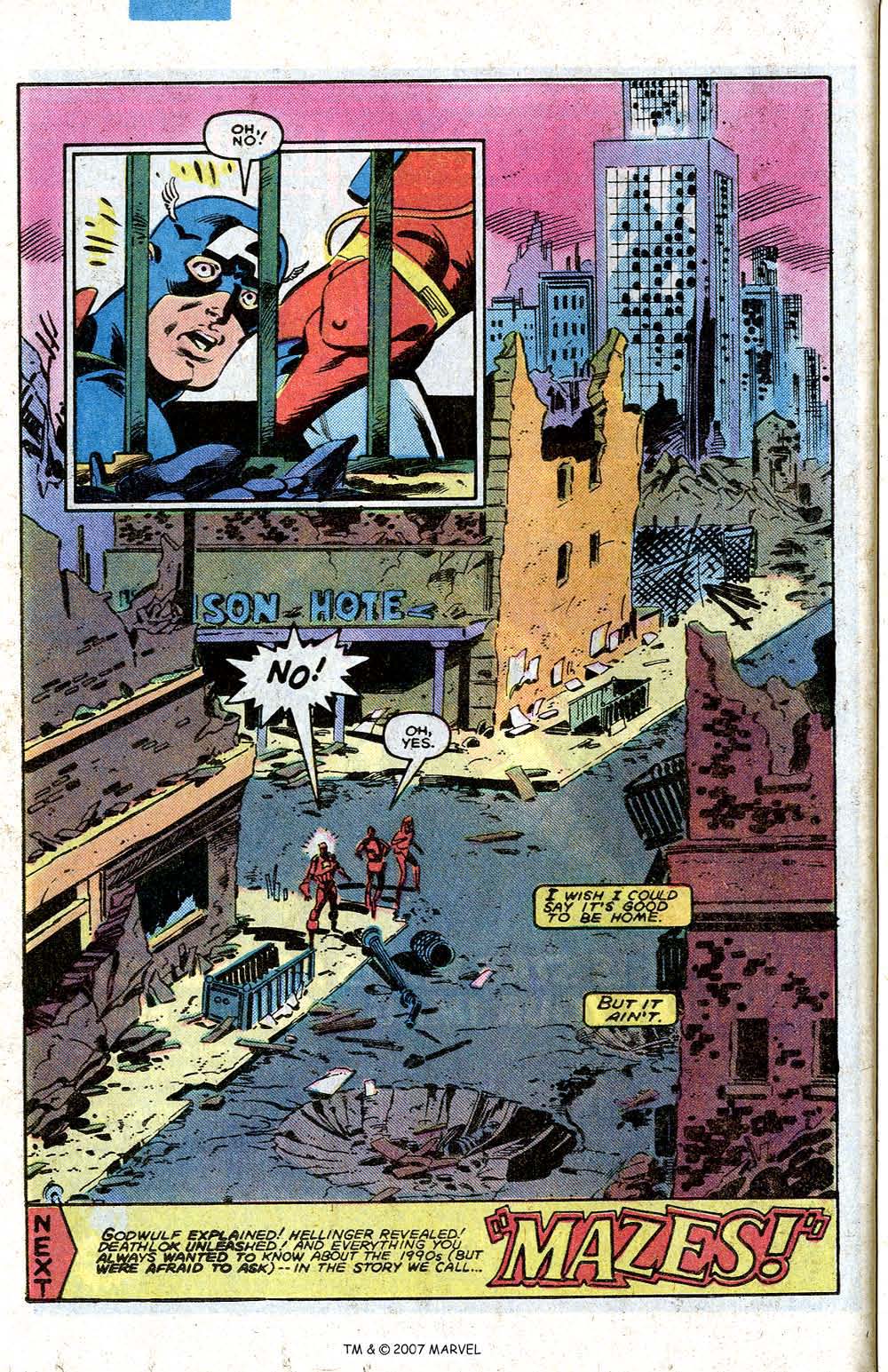 Thoughts: Thoughts: Okay, we now know why Luther was becoming weaker and we get the explanation of what happened to Deathlok. His body was stolen from a SHIELD depot, by Roxon agents, he was converted to a fully robotic form, which was destroyed at Project Pegasus, while the organic matter was preserved. After that failure, new cybernetic parts were added to the organic matter and Deathlok was reborn. The Luther clone provided the missing link, of Luther's mind and memories. Deathlok is again reborn. Meanwhile, Cap learns that every superhero disappeared in 1983, leading to the nightmare future of 1991. in the previous issue, Luther mentions that Ryker had worked for Brand, in the past, before the war games that killed Luther Manning. So, we have a bit of retroactive clean-up from Project Pegasus and a hint as to how Deathlok's future arises, despite superheroes in the past. The question is, what causes everyone to disappear in 1983? That is a mystery, still... Everything is still engaging and we have the further intrigue of what happened to everyone in 1983. Cap is now in that nightmare future. You know we are coming back for the next part!
|
|
|
|
Post by codystarbuck on Jun 7, 2018 16:34:34 GMT -5
Captain America #288 Creative Team: Creative Team: no changes Synopsis: Cap, Deathlok and Godwulf look at the ruined remains of New York City. Godwulf relates his past, as an agent of Brand...  The Nth Command was to wipe out the existence of the big superhero groups, allowing the individual heroes to be hunted and destroyed, leaving America open to Brand and its parent, Roxxon. Deathlok was to lead the assault on Washington. Fighting broke out, with the CIA splintering off, as well as the military. Ryker grew to power and the Middle East exploded, leading to the destruction of New York. Hellinger is still a threat, trying to consolidate power. Cap and Deathlok are introduced to Godwulf's friends: Sage, Swashbuckler, Gentle Sam, Big Man, and Iron Butterly ... 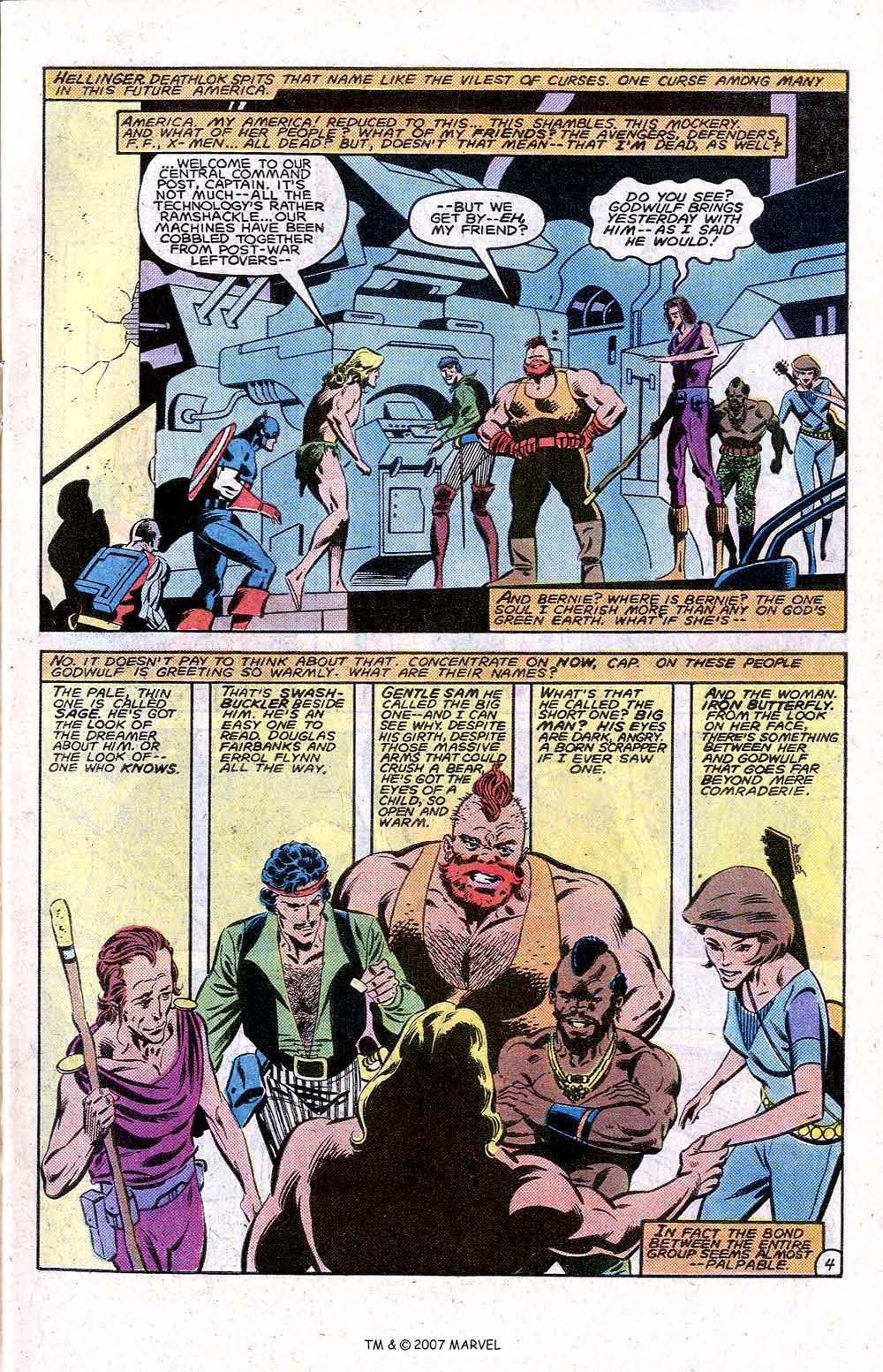 They are lll former Nth Commandos, who wish to atone for their past. Their goal is the destruction of Hellinger, aka Harlan Ryker, the man who created Deathlok. Hellinger has more Alpha Mech doomsday weapons and must be stopped. Deathlok asks why he was sent to the past and Godwulf says he merely wished to temporarily remove deathlok so Hellinger couldn't track him; but, he got pulled away (the events of Marvel Spotlight #33 and MTIO 27). He says Ryker realized that Deathlok was the key thing lacked by Godwulf's group, a symbol to rally around. Cap tries to make Deathlok see the truth...  Cap is given the chance to return to the present; but stays to aid in the assault on Hellinger's compound. The battle is vicious and the group make it inside, only to be dumped in a maze. Slowly, pairs are separated from the group, until only Deathlok and Cap are left to face Hellinger. Hellinger takes control of Deathlok's computer and orders him to shoot Cap in the back. he then prepares to launch the Alpha-Mechs when Luther Manning's mind re-takes control and he fires on Hellinger, destroying his cyborg body. 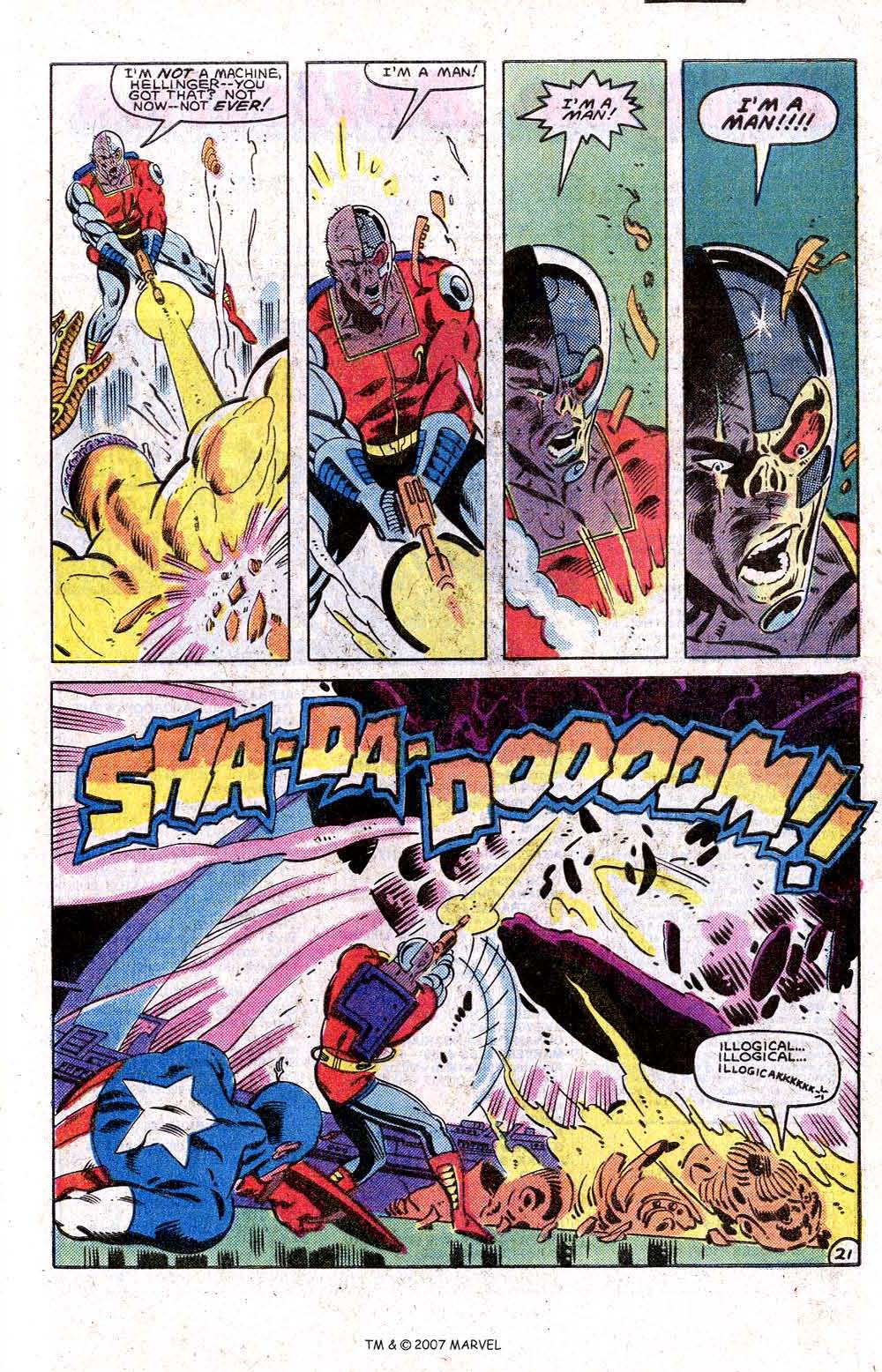 The future is freed of Ryker. Cap returns to the past to face the Nth Command. There is a brief interlude catching up bernie and her sister, then Jack and his lady, who kisses him, knocking him out. She has set up the whole situation. Thoughts: Interesting ending to the Deathlok Saga. There is plenty of action; but, in the end, the key is a philosophical one. It takes Luther manning's humanity to finally stop Hellinger and begin the rebuilding of the future of 1991. Deathlok is a symbol of rebellion against the Ryker's and even the CIA. He is,as Cap says, a symbol of what America has become, yet he has established his independence. This era of Captain America was filled not only with action; but, also philosophical debates and metaphors. Bernie learned that Captain America is Steve Rogers when she witnesses Cap deliver the same speach about tolerance to even negative viewpoints that Steve had previously uttered to one of their friends. Cap faces many challenges to the idea of the power of the common man, reborn fascism, and now corporate domination of society, a hot topic of the 80s and one that still resonates, as corporations have gained power to the point that they put one of their own in the White House. Sometimes the metaphors worked and sometimes they didn't; but, this was a great time to read Captain America. it would continue under Mark Gruenwald, as he took it further, with threats like Flag Smasher, Left and Right Winger, the Watchdogs and more. He seemed to want to explore Cap as a symbol of what America aspired to, as he faced what America is, or could become, if it continues down the wrong path. With occasional sidesteps into werewolves and such. Deathlok was a dystopian anti-hero, fighting a military-controlled nightmare future, created in the after-math of Vietnam and Watergate. It reflected the anxieties of its time, when nuclear destruction seemed to be the future, and not necessarily the distant future. Here, that is tweaked to be the military-industrial complex that President Eisenhower warned about, which holds much sway on America's foreign policy and economy. DeMatteis ads the anxieties of the "Greed is Good" generation, who had been unleashed on Wall Street and had their claws in the highest levels of government pushing deregulation and hamstringing of unions. The Reagan Administration was quite sympathetic to that ideology and the results can be seen in the massive profits that were made on Wall Street, the bubble and burst cycles that became prominent, the growth of international conglomerates, the downsizing and exportation of jobs, and the repealing of government restrictions on monopolistic practices. Business did quite well in this period, while real wages began the downward spiral, leading to current income gaps. In DeMatteis version of this nightmare, the corporations created their own coup opportunity, though it escaped their control. Both versions reflect the anxieties of the future, in the time they were written. You can debate whether those futures are worse that what we really got, across the 90s and into the new Millennium, though at least we don't have cannibals, cyborg killers, and nuclear robots. Yet. Both are warnings, though, that too much power in any one groups hands tends not to end well for society as a whole. That is pretty much the end of Luther Manning (I don't count later returns). Marvel seemingly removed this future from being, as Cap is able to sabotage the Nth Commands equipment, preventing their null projectors from working, making them easy pickings for the Avengers, defenders, FF and X-Men. The rest of that issue (#289) features a humorous dream of Bernie's, where she becomes Bernie America, Sentinel of Liberty (it was Assistant Editor month, with gag stories). Deathlok would not return until 1990, the time period of the original series (not a coincidence). It returned as a story of the present, where African-American Michael Collins is the brain for a new Deathlok, created by the Roxxon subsidiary, Cybertech. Collins was tricked into working on the project and uncovers its true purpose. He is double-crossed and his brain is wired into the Deathlok cyborg, to control it (it electrocuted the brain other previously occupied it's skull. Collins' mind re-exerts control and breaks away from Cybertech's programming. The series was written by Dwayne McDuffie and Gregory Wright, with art by Jackson Guice and Scott Williams. It had moments, and had a good idea at the heart, with an updating of Moench and Buckler's concept, with the gimmick of it occuring today, the time of the dystopian future of the original. However, that mini-series spawned a regular series, which fell more in line with the amoral and violent trend of anti-heroes that was prevalent in the 90s and it turned me right off. Guice and Williams give it the full Image look, as that was becoming the scratchy norm for the day (though the Image crew were still at Marvel). I bailed on the series quickly and never felt the renewed concept had the same imagination as the original. Looking back, the original was a bit scattershot and it's middle portion was pretty uneven, while the ending seemed a bit rushed (and there is the whole chaotic aftermath). Marvel wasn't content to let Deathlok be its own thing, which helped speed its demise. The 1990 mini-series was quite good, even if I'm not wild about the art and I was excited to read it, then. The subsequent series is really what turned me off of the idea (same with the Nick Fury vs SHIELD mini and the SHIELD series that followed). It just became yet another violent protagonist in a boring comic, to me, along with Ghost Rider, the Punisher, and Wolverine. That is what really helped to push me more into the indie comic world, looking for anything other than those kinds of comics. The original is no less violent; but, it seemed to have more spark to it, more of a reflection of the period, more imagination. At least, while Moench was scripting. That was the part I really missed, even before the conclusion of the original series. Moench could write pulp and Deathlok was dystopian pulp, at its heart. Pulp may seem disposable; but, there is a craft at the center of it and that seemed lacking, in many 90s comics. McDuffie had written better comics (Damage Control) and would do better with the Milestone books, and his later work on Justice League and comics that followed that gig. Doug Moench would continue to write some of the best stuff at Marvel, in Moon Knight and Master of Kung Fu, before he had a blow up with Jim Shooter and went to DC (while do a few indie projects). Rich Buckler ended up working mostly for DC, doing covers and the odd issue or treasury (Superman vs Shazam, for instance), before editing the Archie Red Circle line and the Solson line of junk. After that, his profile diminished, as he did bits and pieces, here and there, concentrating more on his surrealist paintings. He passed away last year, after seeing his creation sort of transferred to the screen, on Agents of SHIELD. I still tink the original Deathlok concept is ripe for a movie, though Terminator stole as much from it as it did Harlan Ellison (and Buckler probably swiped Harlan's work, at the beginning); so, it isn't unique enough. Universal Soldier also stole more than a bit from the idea. That doesn't leave much to work with, from a Hollywood point of view. So, I close out my look at the original Deathlok, with the last commercial image of the character, from creator Rich Buckler; the variant cover for 2014's Deathlok series: 
|
|
|
|
Post by rberman on Jun 7, 2018 16:49:49 GMT -5
Thanks for the review! Marvel and DC both did variations on the "man turned into a machine battles his programming to find his inner humanity." As you mentioned, quite a few movies have done the same. Certainly the Deathlok seen on "Agents of S.H.I.E.L.D." on TV has this angle.
|
|
|
|
Post by brutalis on Jun 8, 2018 8:02:41 GMT -5
Man I love that Cap 286 cover. So much that I just bought it as an art print from Mike Zeck at this years Phoenix Comic-Fest. Signed it as well. Going up on my wall this weekend next to another print of Zeck's from GI JOE with Snake-Eyes and Scarlett.
I really enjoyed the MTIO appearances and thought Ron Wilson did a wonderful job with Deathlok and captured much of the Buckler and Pollard styling's in the art. Of course Byrne and Perez made "Lok look amazing but their versions were almost too shiny and clean and super-heroic. I prefer the dark, dirty and beaten up/broken down/damaged nightmarish version Buckler/Janson gave us. Zeck combined both the sleek/clean style and the down and dirty aspects making Deathlok a lean, mean killing cyborg machine!
This 3 part finale did a splendid job of ending the Manning Deathlok story while leaving you wishing for a continuation as a mini-series (anytime now MARVEL< get it together damn you!) to see Deathlok fighting and learning to be a living symbol of hope and dreams and not the nightmare he believes himself to be. It was nice to see that Manning's humanity itself was the most important piece of the puzzle which won the day in the end.
|
|
|
|
Post by chaykinstevens on Jun 9, 2018 6:15:29 GMT -5
I'd forgotten that Captain Amerrica #288 featured a character named Swashbuckler - a nice tribute to Deathlok's creator. Have you read the short Deathlok backup strip in Marvel Fanfare #4 by David Anthony Kraft and Michael Golden, set before Astonishing Tales #25 iirc? Doug Moench went on to do Electric Warrior with Jim Baikie for DC and Coldblood with Paul Gulacy in Marvel Comics Presents, both of which revisited some of the ideas from Deathlok. I think Moench had intended to do a prestige format Coldblood series with Malcolm Jones, but this seems to have been dropped following Jones's sad death. Rich Buckler, who didn't seen to care much about copyright issues, may have used Godwulf again in Galaxia Magazine #1, which also featured Gideon Cross under the name Bloodwing. Another later comic, Forever Warriors, said to be by Buckler and Roy Thomas, apparently also featured Godwulf, but I've never seen a copy and it's too obscure even for GCD.   |
|
|
|
Post by codystarbuck on Jun 9, 2018 9:44:51 GMT -5
I'd forgotten that Captain Amerrica #288 featured a character named Swashbuckler - a nice tribute to Deathlok's creator. Have you read the short Deathlok backup strip in Marvel Fanfare #4 by David Anthony Kraft and Michael Golden, set before Astonishing Tales #25 iirc? Doug Moench went on to do Electric Warrior with Jim Baikie for DC and Coldblood wuth Paul Gulacy in Marvel Comics Presents, both of which revisited some of the ideas from Deathlok. I think Moench had intended to do a prestige format Coldblood series with Malcolm Jones, but this seems to have been dropped following Jones's sad death. Rich Buckler, who didn't seen to care much about copyright issues, may have used Godwulf again in Galaxia Magazine #1, which also fetured Gideon Cross under the name Bloodwing. Another later comic, Forever Warriors, said to be by Buckler and Roy Thomas, apparently also featured Godwulf, but I've never seen a copy and it's too obscure even for GCD.   He also stuck Deathlok into the first issue of Solson's Reagan's Raiders. |
|
|
|
Post by beccabear67 on Jun 13, 2018 21:05:12 GMT -5
You've got me interested again in Deathlok, thanks! Well, my bank account doesn't thank you but you know...
I actually had a giant b&w poster of Captain America #286's cover. It was a door prize of some kind from a comic shop. It was folded in four. I bet you'll hate what I did with it though; I got out the colored pencils and enjoyed myself! It's long gone I think whatever state it would still be in, maybe I'll find it in a drawer someday howveer, you never know (and that Hulk with the first Rocket Racoon will be with it). I did buy those Captain Americas too, I think I fell off from buying the title with #292.
|
|
|
|
Post by codystarbuck on Jun 14, 2018 9:50:43 GMT -5
I had stopped at the end of the Baron Zemo story, just before, and totally missed the Deathlok story, until later.
|
|
|
|
Post by Reptisaurus! on Jun 15, 2018 10:10:56 GMT -5
So I missed a whole page of team-up book reviews somehow. Now that I see them I have comments.
Team-Up # 46: It SAYS part 2 of 2 but it's arguably part 6 of 8 - Spidey started the time travel storyline with a 4 part Salem Witch trials story in Team-Up 41-44, bounced around time in 45 and 46, and arrived just at the exact moment to fight the Basilisk in a crossover with Marvel Two-in-One. It was one of the top ten most ambitious/epic/longest post-Golden-Age Marvel stories ever up to this point, and (IMO) the high point of Mantlo's generally pretty good run.
The Deathlok crossover specifically might not have been an A +, but the characterization was strong and there was an interesting contrast between the two leads. I suspect Mantlo didn't want to mess up Buckler's story, so he didn't do much of consequence Deathlok-wise.
Two-In-One # 27: Great fun, the creative team just throws EVERYTHING at the wall to see what sticks. This is the only issue of Two-In-One that features the full Fantastic Four in action, on top of Nick Fury, the Impossible Man, and Jimmy Carter. Wolfman and Wilson's run was... not a high point for the tile but this story is just so overstuffed with... stuff that it's consistently good fun.
Two-In-One # 54: The SECOND use of Deathlok as a villain in TIO, which is a little bit of a waste of the character. Still, this was a really strong arc despite the D-list of the D-List guest stars. This was well before Quasar got his own title, so Deathlok was probably the most popular co-star in the whole arc! I never thought about the Andromeda Strain influence before - Good catch! The writing is a little choppy (as Gruenwald and Macchio alternated pages while writing) but this does do an impressive job at building up a strong supporting cast for the Thing beyond Alicia.. for the first time in 6 years of Two-in-One. Crazy that this six issue arc was drawn by the two major fan-favorite artists of the '80s in quick succession.
|
|
|
|
Post by codystarbuck on Jun 15, 2018 12:06:33 GMT -5
So I missed a whole page of team-up book reviews somehow. Now that I see them I have comments. Team-Up # 46: It SAYS part 2 of 2 but it's arguably part 6 of 8 - Spidey started the time travel storyline with a 4 part Salem Witch trials story in Team-Up 41-44, bounced around time in 45 and 46, and arrived just at the exact moment to fight the Basilisk in a crossover with Marvel Two-in-One. It was one of the top ten most ambitious/epic/longest post-Golden-Age Marvel stories ever up to this point, and (IMO) the high point of Mantlo's generally pretty good run. The Deathlok crossover specifically might not have been an A +, but the characterization was strong and there was an interesting contrast between the two leads. I suspect Mantlo didn't want to mess up Buckler's story, so he didn't do much of consequence Deathlok-wise. Two-In-One # 27: Great fun, the creative team just throws EVERYTHING at the wall to see what sticks. This is the only issue of Two-In-One that features the full Fantastic Four in action, on top of Nick Fury, the Impossible Man, and Jimmy Carter. Wolfman and Wilson's run was... not a high point for the tile but this story is just so overstuffed with... stuff that it's consistently good fun. Two-In-One # 54: The SECOND use of Deathlok as a villain in TIO, which is a little bit of a waste of the character. Still, this was a really strong arc despite the D-list of the D-List guest stars. This was well before Quasar got his own title, so Deathlok was probably the most popular co-star in the whole arc! I never thought about the Andromeda Strain influence before - Good catch! The writing is a little choppy (as Gruenwald and Macchio alternated pages while writing) but this does do an impressive job at building up a strong supporting cast for the Thing beyond Alicia.. for the first time in 6 years of Two-in-One. Crazy that this six issue arc was drawn by the two major fan-favorite artists of the '80s in quick succession. It was an easy catch; Gruenwald and Macchio were open about the Andromeda Strain influence from the beginning. These days, people tend to forget that Byrne and Perez (and Simonson) had long stretches of working on lesser titles, like the team-up books and stories in the anthology titles. |
|
|
|
Post by beccabear67 on Jun 15, 2018 20:46:13 GMT -5
I ordered the two Two-In-Ones but skipped the Team-Up, I hope it won't be essential.
|
|
|
|
Post by Reptisaurus! on Jun 15, 2018 22:50:32 GMT -5
ALL TEAM UP BOOKS ARE ESSENTIAL!!
😀
|
|
|
|
Post by codystarbuck on Jun 15, 2018 23:55:23 GMT -5
I ordered the two Two-In-Ones but skipped the Team-Up, I hope it won't be essential. The Marvel Team-Up, with Spidey and Deathlok doesn't really ad anything to the Deathlok story and more serves as a journey for Spider-Man, as he was timehopping from the past to a couple of nightmare futures (Killraven's and Deathlok's). The MTIO have more bearing on Deathlok's history, as it brings him into the present and ultimately leads to the Captain America story. |
|
|
|
Post by EdoBosnar on Jun 16, 2018 2:43:47 GMT -5
I ordered the two Two-In-Ones but skipped the Team-Up, I hope it won't be essential. Hmm, kind of odd to me. The second M2in1 appearance is, as noted above, smack dab in the middle of Project Pegasus - which is really an awesome story. Can't imagine just reading one installment of that. And the Marvel Team-up story may not mean much to the overall Deathlok saga, but it's part of a longer Spidey time-hopping arc which, as Reptisaurus observed, one of the highlights of Mantlo's run as writer on the title.
|
|




















